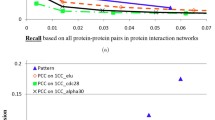Abstract
It is important to detect interaction effect of multiple genes during certain biological process. In this paper, we proposed, from systems biology perspective, the concept of co-regulated gene module, which consists of genes that are regulated by the same regulator(s). Given a time series gene expression data, a hidden Markov modelbased Bayesian model was developed to calculate the likelihood of the observed data, assuming the co-regulated gene modules are known. We further developed a Gibbs sampling strategy that is integrated with reversible jump Markov chain Monte Carlo to obtain the posterior probabilities of the co-regulated gene modules. Simulation study validated the proposed method. When compared with two existing methods, the proposed approach significantly outperformed the conventional methods.
Similar content being viewed by others
References
Mootha V K, Lindgren C M, Eriksson K F, Subramanian A, Sihag S, Lehar J, Puigserver P, Carlsson E, Ridderstråle M, Laurila E, Houstis N, Daly M J, Patterson N, Mesirov J P, Golub T R, Tamayo P, Spiegelman B, Lander E S, Hirschhorn J N, Altshuler D, Groop L C. PGC-1alpha-responsive genes involved in oxidative phosphorylation are coordinately downregulated in human diabetes. Nature Genetics, 2003, 34(3): 267–273
Hartwell L H, Hopfield J J, Leibler S, Murray AW. From molecular to modular cell biology. Nature, 1999, 402(6761 Suppl): C47–C52
Wang L, Zhang B, Wolfinger R D, Chen X. An integrated approach for the analysis of biological pathways using mixed models. PLoS Genetics, 2008, 4(7): e1000115
Gu J, Chen Y, Li S, Li Y. Identification of responsive gene modules by network-based gene clustering and extending: Application to inflammation and angiogenesis. BMC Systems Biology, 2010, 4(1): 47
Eisen M B, Spellman P T, Brown P O, Botstein D. Cluster analysis and display of genome-wide expression patterns. Proceedings of the National Academy of Sciences of the United States of America, 1998, 95(25): 14863–14868
Tavazoie S, Hughes J D, Campbell M J, Cho R J, Church G M. Systematic determination of genetic network architecture. Nature Genetics, 1999, 22(3): 281–285
Tamayo P, Slonim D, Mesirov J, Zhu Q, Kitareewan S, Dmitrovsky E, Lander E S, Golub T R. Interpreting patterns of gene expression with self-organizing maps: Methods and application to hematopoietic differentiation. Proceedings of the National Academy of Sciences of the United States of America, 1999, 96(6): 2907–2912
Carter S L, Brechbühler C M, Griffin M, Bond A T. Gene coexpression network topology provides a framework for molecular characterization of cellular state. Bioinformatics, 2004, 20(14): 2242–2250
Davidson G S, Wylie B N, Boyack K W. Cluster stability and the use of noise in interpretation of clustering. In: Proceedings of IEEE Symposium on Information Visualization 2001. 2001, 23–30
Elo L L, Järvenpää H, Oresic M, Lahesmaa R, Aittokallio T. Systematic construction of gene coexpression networks with applications to human T helper cell differentiation process. Bioinformatics, 2007, 23(16): 2096–2103
Rabiner L R. A tutorial on hidden Markov models and selected applications in speech recognition. Proceedings of the IEEE, 1989, 77(2): 257–286
Baum L E, Petrie T, Soules G, Weiss N. A maximization technique occurring in statistical analysis of probabilistic functions of Markov chains. Annals of Mathematical Statistics, 1970, 41(1): 164–171
Green P J. Reversible jump Markov chain Monte Carlo computation and Bayesian model determination. Biometrika, 1995, 82(4): 711–732
Strauss D J. Clustering algorithms — Hartigan, JA. Biometrics, 1975, 31(3): 793
Oldham M C, Horvath S, Geschwind D H. Conservation and evolution of gene coexpression networks in human and chimpanzee brains. Proceedings of the National Academy of Sciences of the United States of America, 2006, 103(47): 17973–17978
Horvath S, Zhang B, Carlson M, Lu K V, Zhu S, Felciano R M, Laurance M F, Zhao W, Qi S, Chen Z, Lee Y, Scheck A C, Liau L M, Wu H, Geschwind D H, Febbo P G, Kornblum H I, Cloughesy T F, Nelson S F, Mischel P S. Analysis of oncogenic signaling networks in glioblastoma identifies ASPM as a molecular target. Proceedings of the National Academy of Sciences of the United States of America, 2006, 103(46): 17402–17407
Zhang B, Horvath S. A general framework for weighted gene coexpression network analysis. Statistical Applications in Genetics and Molecular Biology, 2005, 4: Article17
Tang W, Wu X, Jiang R, Li Y. Epistatic module detection for casecontrol studies: A Bayesian model with a Gibbs sampling strategy. PLoS Genetics, 2009, 5(5): e1000464
Author information
Authors and Affiliations
Corresponding author
About this article
Cite this article
Tang, W., Li, R., Li, S. et al. Co-regulated gene module detection for time series gene expression data. Front. Electr. Electron. Eng. 7, 357–366 (2012). https://doi.org/10.1007/s11460-012-0207-x
Received:
Accepted:
Published:
Issue Date:
DOI: https://doi.org/10.1007/s11460-012-0207-x




